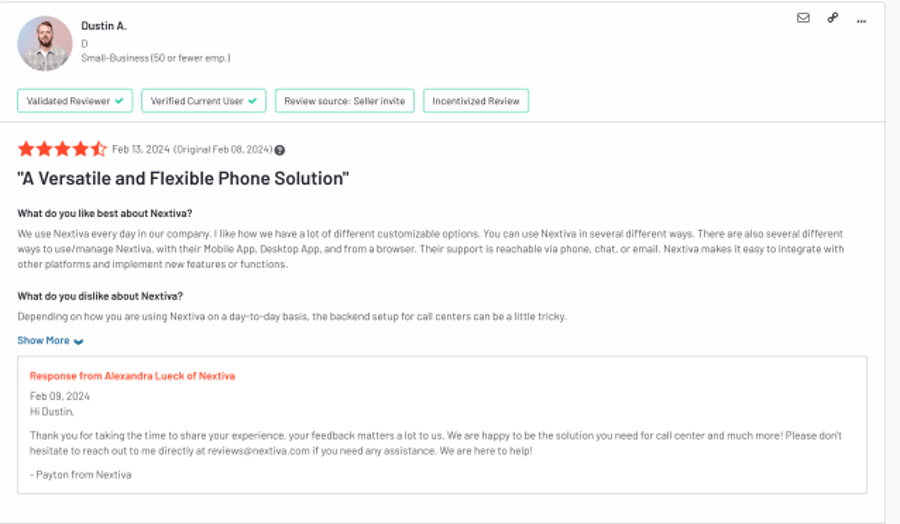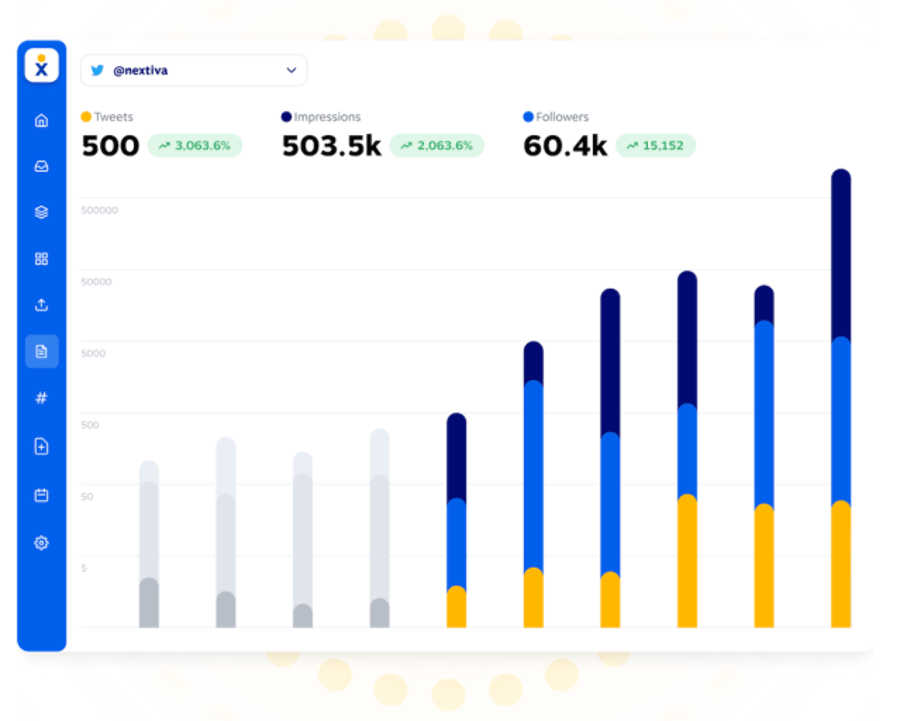With consumers relying so heavily on online reviews and ratings, your brand’s online reputation can make or break its success. That’s why every business owner needs a solid review management strategy.
By harnessing the power of online reviews, your brand can boost its visibility, build consumer trust, influence customer decisions, and drive business growth.
We’ll walk you through the basics of review management, discuss why it’s needed, and outline the most effective strategies to elevate your online reputation.
We’ll even explore how you can accomplish this task in half the time, without breaking a sweat, with a review management tool.
What is Online Review Management?
Online review management is the process of monitoring, analyzing, and responding to customer reviews posted online about a business, product, or service. It involves various activities such as:
- Monitoring: Keeping track of what customers are saying about a business across different platforms, such as review websites (e.g., Yelp, TripAdvisor), social media, and the business’s own website.
- Analyzing: Assessing the content of reviews to understand customer satisfaction levels, identifying common themes or issues, and gaining insights into areas of the business that may need improvement.
- Responding: Engaging with reviewers by thanking them for positive reviews and addressing any concerns or negative feedback in a constructive manner.
The goal of online review management is to improve customer satisfaction and perception of a business, influence potential customers, and ultimately drive business growth. It allows businesses to create a positive online presence, manage their reputation, and make informed decisions based on customer feedback.

Why Does Online Review Matter?
Customer reviews have become the best way for shoppers to evaluate your brand’s reputation and make informed purchasing decisions. Reviews provide first-hand accounts of your trustworthiness, service, and products.
Nowadays, business reviews aren’t just a reflection of your brand; they’re an integral part of your identity and reputation. According to research:
- 52% of a company’s market value is attributed to its reputation (Zignal Labs).
- 99% of customers read reviews at least “sometimes” when shopping online (Power Reviews).
- 81% of consumers scope out Google reviews to evaluate local businesses (Exploding Topics).
Reviews impact the bottom line
Your customer reviews have the power to shape your reputation in addition to:
- 📈 Raising search engine rankings. Reviews raise your online visibility and local search optimization. The greater your brand awareness, the easier it is for shoppers to discover and buy from you.
- ✅ Building consumer trust. When assessing a brand’s authenticity and credibility, a five-star rating or review of your products/services is the social proof that shoppers need to see. Positive reviews reassure customers when buying from new or small businesses.
- 💳 Influencing purchase decisions. Displaying product reviews on landing pages, email messages, and ads increases conversion rates by up to 380%.
- 💬 Gathering feedback to improve. Reviews provide valuable insights into customer satisfaction, helping brands identify areas for improvement. Implementing this feedback drives customer loyalty and revenue.
Online reviews impact your business reputation. And your reputation influences your competitiveness in the market. That’s why the top brands actively manage their reputation using an online review management strategy.
How to Create an Effective Review Management Strategy: 7 Steps
To implement a successful social media and review management strategy, here are seven key steps to take:
1. Claim and Optimize Your Business Profiles Across Platforms
To start, make sure your business is listed on all relevant review platforms. The most important ones include Google Business Profile (formerly Google My Business), Yelp, and TripAdvisor.
For example, Google Business Profile is particularly crucial for any business that operates on a local scale. This platform ensures that when someone searches for products or services “near me,” your business has a chance to appear in the search results. A well-optimized Google Business Profile can significantly enhance your visibility in local searches, driving more foot traffic to your storefront or local business.
However, don’t overlook industry-specific platforms that could be highly relevant to your target audience.
For instance, if you’re in the hospitality industry, sites like Booking.com or Zomato for restaurants can be invaluable. Claiming your profile is often free and gives you control over the information presented to potential customers.
How to Optimize Your Business Profiles
Optimizing your profiles goes beyond merely claiming them. Ensure all your business information is accurate, including your name, address, phone number, and operating hours. Inconsistencies across platforms can confuse potential customers and negatively impact your search rankings.
- Use Eye-Catching Visuals. High-quality images of your products, services, or physical location can make your profile stand out. Consider hiring a professional photographer to capture your business in the best light. Regularly updating your photos can also keep your profile fresh and engaging.
- Incorporate Keywords. Including relevant local search keywords and phrases in your business description and posts can improve your visibility in search results. Research the keywords your potential customers are using to find businesses like yours and incorporate them naturally into your content.
- Maintain Consistent Branding. Your tone, voice, and branding should be consistent across all platforms. This consistency helps in building brand recognition and trust. Your profile should reflect your brand’s personality, whether it’s professional, friendly, quirky, or anything in between.
Encourage Customers to Leave Reviews
First, it’s essential to recognize the significant impact customer reviews have on your business.
Research consistently shows a strong link between reviews and consumer behavior. For example, 65% of consumers are more likely to leave reviews when prompted by a business. What’s more, around 80% of online reviews come from follow-up emails, which shows the importance of reaching out to your customers after a purchase or interaction.
How to Encourage Customers to Leave Review
- Time Your Request Well. The timing of your review request greatly influences the likelihood of receiving feedback. The optimal moment to ask for a review is after a successful transaction or interaction when the customer’s satisfaction is highest. This moment could vary depending on the nature of your business.
- For instance, a restaurant might send a review request after a diner’s visit, while an online retailer might wait until confirmation that an order has been delivered and had time to be assessed by the customer.
- Simplify the Review Process. Making the review process as straightforward as possible is crucial in encouraging customer participation. The fewer steps and the less time it takes to leave a review, the better.
Here are some strategies to simplify this process:- Direct Links: Include direct links in follow-up emails or business SMS messages that take customers right to the review platform. This removes barriers by eliminating the need for customers to navigate the site themselves.
- QR Codes: For physical businesses, printing a QR code on receipts or business cards that customers can scan to leave a review can be highly effective. This method is particularly useful for engaging customers in real-time, shortly after their purchase or visit.
- Streamline Instructions: Provide clear, concise instructions on how to leave a review. A simple step-by-step guide can help reduce any confusion or reluctance.
- Direct Links: Include direct links in follow-up emails or business SMS messages that take customers right to the review platform. This removes barriers by eliminating the need for customers to navigate the site themselves.
- Make Review Requests Personal. Personalized messages make customers feel valued and recognized, increasing their likelihood of leaving feedback. To add a personal touch, address customers by name and reference the specific product or service they purchased.
- Offer Multiple Platforms for Feedback. While it is important to guide customers to platforms where their reviews will have the most impact (like Google, Yelp, or industry-specific sites), offering choices can enhance their willingness to participate. Some customers may prefer leaving feedback on social media or a platform they’re more familiar with or trust more.
- Acknowledge and Reward Feedback. Acknowledging every positive or negative review demonstrates to customers that their feedback is valued and taken seriously. Additionally, consider offering incentives for leaving a review, such as discounts on future purchases or entry into a prize draw. However, ensure that incentives comply with the review platform’s guidelines to avoid penalties.

3. Respond Promptly, Professionally, and Consistently
Responding to customer reviews is not just a ‘courtesy’—it’s a powerful tool in building a positive brand image and fostering customer loyalty. A significant 90% of consumers report that they are more likely to patronize a business that actively responds to all reviews, both positive and negative.

How To Respond To Customer Reviews
- Aim to Quick Responses. Prompt responses demonstrate to customers and potential customers that you are attentive and value feedback. Aim to respond to reviews as quickly as possible—within 24 to 48 hours is ideal. This quick turnaround is particularly crucial for negative reviews, where timely acknowledgment can help mitigate dissatisfaction and sometimes even turn a negative experience into a positive one.
- Be Professional At All Times. Every response you post publicly reflects your brand. Maintain a professional tone in all interactions, even when addressing negative feedback. Being professional in your responses reassures customers and prospects that your business handles praise and criticism with grace.
- Personalize Your Responses. Personalization can transform a standard response into a meaningful interaction. Use the reviewer’s name and reference specific points they mentioned in their review to show that you’ve carefully considered their feedback. Personalized responses not only demonstrate that you value the feedback but also help in building a connection with your audience.
- Showcase Your Brand Personality. Responding to reviews presents an opportunity to express your brand’s personality. For positive reviews, go beyond a simple “thank you” by injecting your brand’s voice into your response, whether it’s warm and friendly, witty, or professional. This approach not only makes your response more engaging but also helps in reinforcing your brand identity.
- Handle Negative Reviews. Addressing negative feedback offers a unique opportunity to showcase your commitment to customer satisfaction.
- Acknowledge the issue,
- offer an apology if appropriate,
- and suggest a way to resolve the problem.
This could involve inviting the customer to discuss the matter offline or offering a solution directly. Handling negative reviews well can sometimes convert dissatisfied customers into loyal ones and shows prospective customers that you’re committed to excellence.
- Consistency Across Platforms. Ensure your response strategy is consistent across all review platforms. This consistency helps in maintaining a cohesive brand image and ensures that all your customers feel valued, regardless of where they choose to leave feedback.
4. Handle Negative Reviews Like A Pro
How you handle one-star reviews significantly impacts your brand reputation. Instead of viewing these as embarrassing setbacks, consider them opportunities to show off your stellar customer service and problem-solving skills.
- Acknowledge Quickly. Over half of customers expect businesses to respond to negative feedback within a week, and a significant portion (one in three customers) expect a response in three days or less. A prompt response demonstrates that your business values customer feedback and is proactive in addressing concerns.
- Move the Conversation Offline. Whenever possible, attempt to take the conversation offline by inviting the customer to call or email you to discuss their concerns further. This approach allows for a more personal and detailed conversation and demonstrates your willingness to go the extra mile to resolve the issue. Moreover, it helps prevent the escalation of the situation in a public forum and provides an opportunity to transform a dissatisfied customer into a loyal supporter.
- Respond with Respect and Empathy. Always address customer concerns with respect and a genuine willingness to solve the problem. Apologize for any inconvenience the customer may have experienced, even if the issue was beyond your control. Demonstrating empathy and understanding can significantly affect how your response is perceived, not just by the aggrieved party but by other customers who read the exchange. Avoid getting defensive or escalating conflicts, as this can further damage your brand’s reputation.
- Training for Empathy. Given the importance of empathy in communication, it may be beneficial to train your employees on how to express empathy. This training can equip them to handle negative feedback in a way that reinforces your brand’s values and commitment to customer satisfaction. Showing empathy is crucial, as 68% of customers expect brands to demonstrate understanding and compassion in their interactions.
- Remember To Follow-Up. After resolving the customer’s issue, follow up to ensure they are satisfied with the solution. This follow-up can reinforce the customer’s importance to your business and shows a commitment to ensuring their satisfaction. Satisfied customers are often willing to update their review or spread positive word of mouth about their experience.
💡Key Note → Even when taking the conversation offline, it’s essential to leave a public response to the original review. This response should briefly acknowledge the feedback, express your commitment to resolving the issue, and indicate that you’ve reached out or are inviting the customer to contact you directly.
Related: Online Brand Monitoring: Top Tips & Common Blind Spots
5. Showcase Your Reviews Everywhere
Leveraging customer reviews across multiple channels is a powerful strategy to build trust and credibility with potential customers. Here’s how to amplify the impact of your reviews by showcasing them in strategic locations.
- Integrate Reviews on Your Website. Your website is often the first point of contact with potential customers, making it an ideal platform to showcase positive reviews. Consider these strategies:
- Customizable Widgets: Many review platforms offer widgets you can integrate into your website to display recent reviews. Place these widgets on your landing pages, product pages, or even the homepage to catch visitors’ attention as soon as they arrive on your site.
- Conversion Impact: Featuring customer reviews on your website can significantly increase conversion rates. Some studies suggest that having reviews on a landing page can boost conversion rates by up to 270%. This increase is attributed to the trust and credibility that real customer testimonials bring to your brand.
- Customizable Widgets: Many review platforms offer widgets you can integrate into your website to display recent reviews. Place these widgets on your landing pages, product pages, or even the homepage to catch visitors’ attention as soon as they arrive on your site.
- Feature Reviews in Product Galleries.
- User-Generated Content: Reviews that include user-generated content, such as photos or videos of the product in use, are particularly influential. They provide authentic proof of your product’s value and performance, enhancing trust among potential customers. If possible, encourage customers to submit photos or videos alongside their reviews.
- Highlight in Galleries: Incorporate these user-generated reviews into your product image galleries. Seeing the product “in action” through the eyes of another customer can significantly influence purchasing decisions.
- User-Generated Content: Reviews that include user-generated content, such as photos or videos of the product in use, are particularly influential. They provide authentic proof of your product’s value and performance, enhancing trust among potential customers. If possible, encourage customers to submit photos or videos alongside their reviews.
- Leverage Reviews in Marketing Campaigns.
- Case Studies and Testimonials: Transform positive reviews into detailed case studies or featured testimonials in your marketing materials. This approach can be particularly effective for B2B businesses, where detailed case studies can illustrate how your product or service has solved problems for similar clients.
- Email and Social Media: Include standout reviews in your email newsletters or as part of your social media content. Sharing positive feedback in these channels not only showcases customer satisfaction but also encourages others to leave their reviews.
- Product Launches: Highlighting positive reviews during product launches can provide social proof and generate excitement about the new offering.
- Case Studies and Testimonials: Transform positive reviews into detailed case studies or featured testimonials in your marketing materials. This approach can be particularly effective for B2B businesses, where detailed case studies can illustrate how your product or service has solved problems for similar clients.

6. Ensure consistent monitoring
Keep a close eye on your online presence across various review platforms and regularly monitor for new feedback. Set up automatic alerts and escalation workflows so qualified team members can jump in and help swiftly.
How To Enhance Your Monitoring Strategy To Stay Ahead.
- Implement Automated Alerts.
Use the alert systems provided by review platforms or invest in a comprehensive reputation management tool that can monitor multiple platforms simultaneously. These systems can notify you in real-time when your business receives a new review, allowing you to respond promptly. Customize these alerts based on specific criteria such as review rating thresholds or keywords that might indicate a critical issue. This enables you to prioritize responses and manage your time effectively.
- Develop Escalation Workflows.
Assign specific team members or departments to monitor reviews and respond appropriately. This clarity in roles ensures that responses are timely and that the person best equipped to address the feedback is the one who does so.
To do this, ensure you create clear escalation paths for handling negative feedback or complex issues. This ensures that more severe concerns are quickly passed to higher-level or more experienced team members for resolution.
- Review Audits Regularly
Beyond real-time monitoring, schedule regular audits of your online reviews across all platforms. This could be weekly, bi-weekly, or monthly, depending on the volume of reviews you typically receive. Audits can help identify overarching trends, areas for improvement, or opportunities to highlight positive customer experiences.
Next, use these audits to analyze trends in the feedback. Look for recurring themes in both positive and negative reviews that could indicate areas of strength or opportunities for improvement in your products or services.
- Engage As Much As You Can
Engagement doesn’t stop at responding to reviews. Always ask customers for feedback after purchases or interactions. This not only increases the volume of reviews but also demonstrates an ongoing commitment to listening and improving based on customer input.
You should also extend your monitoring to social media channels and online forums where customers might discuss your brand. This broader view offers additional insights into customer sentiment and emerging issues.
7. Analyze, learn, and improve
There’s no better (or more cost-effective!) market research than hearing customer feedback about your processes, services, and products. Harness your reviews to:
- Identify recurring issues
- Launch new product offerings
- Iterate new service features
- Improve business processes
The top reputation management tools leverage AI-powered sentiment analysis tools to gauge overall customer feelings and identify trends. You can use this intel to learn what sparks joy or frustration for your customers.
🥊 Pro tip: You don’t have to monitor only your brand. Set up a dashboard tracking complaints about your competitors and reach out to customers tactfully.
Use a Review Management System to Track Online Reviews
Proactively managing your reputation and reviews can improve your customer relationships, enhance your brand image, and contribute to your business success. But it takes a lot of time and effort to do all this work manually.
That’s why the top brands streamline this process with an online reputation management tool and a straightforward system for real-time review handling.

Choosing the Best Review Management Software
Not all review management software solutions are created equal. When comparing options for your brand’s needs, it’s essential to look for:
- Next-generation features. The best review management software should offer review monitoring, sentiment analysis, and response management. Your team should be able to engage automatically or respond in real-time and engage with your audience as often as you like. Nextiva acts like an assistant, always watching and starting the engagement with automated responses to keep your customers engaged.
- Seamless integrations with your existing workflows, CRM, social media, and review platforms. Look for software that consolidates all your reviews in one dashboard. You’ll save time and effort by responding directly to reviews from one central location rather than navigating each separate platform.
- Ease of use. Everyone on your team should be able to adopt the online review management software with minimal training. A user-friendly interface and intuitive navigation enable you and your team to handle customer feedback efficiently.
- Comprehensive reporting and analytics. Dig into detailed analytics and easy-to-understand insights on your review trends, customer sentiment, and overall reputation performance. You can leverage this intel to identify areas for improvement. But you shouldn’t need to hire a data analyst to make sense of it.
Access all the data you need to make better decisions: In-depth dashboards give you insights across locations, roles, and geographies.

What about pricing? Nearly 95% of companies using reputation management software cover the cost with ROI.
Set Up a Standard Review Management Process
Establishing a process for managing reviews is as important as choosing the right review tracking tool. Your strategy should involve:
- Actively monitoring reviews. Program your software to regularly monitor your social media channels and various review platforms (such as Google, Yelp, TripAdvisor, and other industry-specific review sites) 24/7.
- Responding to positive and negative feedback. Create response templates for you and your team to streamline review management while leaving room to add a personal touch.
- Responding as soon as possible. Establish guidelines for response times and set notifications to ensure your team provides prompt interactions.
- Utilizing feedback to improve business operations. Assign someone to analyze common themes or trends in reviews and provide valuable insights into areas that need attention.
Best Practices of Review Management (The Dos and Donts)
The landscape of review management continues to shift as technology advances. If you don’t take advantage of the latest technology, staying ahead of the curve will be impossible.
Embrace these dos and don’ts in your game plan:
❌ Don’t: Ignore or Dismiss Negative Reviews
Research shows that 82% of shoppers specifically seek out negative reviews because they’re skeptical of near-perfect ratings. In many cases, a small dose of negative online reviews actually increases credibility — to a limited degree.
Shoppers spend four times as long on a site when interacting with negative reviews, increasing conversion rates by 67%.
That’s why you should always respond professionally and helpfully to negative reviews. You’ll boost customer trust and your company’s reputation in one stroke.
Remember that positive responses to negative feedback have the power to turn unhappy buyers into loyal customers (and convert loyal customers into brand ambassadors).
✅ Do: Let AI Do the Heavy Lifting in Review Management
Automation and artificial intelligence can streamline review monitoring and response processes.
Thanks to its ability to analyze massive amounts of data, it can easily identify trends, spotlight customer sentiments, and automate responses, simplifying the entire review management process.

By classifying reviews by sentiment and integrating customer data, your review solution can offer suggestions to help your customer support agent respond quicker.
❌ Don’t: Tolerate Fake Reviews
Generating or allowing fake reviews can severely hurt your company’s reputation. It’s unethical and violates the trust of your potential and existing customers. Report all fake reviews through the platform protocols.
The most important review factors for consumers are:
- Star rating
- Legitimacy
- Recency
- Sentiment
- Quantity
Customers quickly realize the difference between legitimate customer sentiment and phony reviews with inflated star ratings.
✅ Do: Treat Customers Right
Think about the drivers behind your negative reviews. Are they all wrong?
Examine your business processes and customer care team to see if there are key areas to improve.
Sharing review trends and stats with senior business leaders can effect change in the right places. Equip your customer support team with tools and autonomy to serve the customer when they need help the most.
Optimizing Your Online Reputation & Review Management
Achieving a stellar online reputation isn’t just about gathering positive reviews — it’s about building trust, showcasing your commitment to exceptional customer experiences, and leveraging feedback for growth.
Reputation management software can empower your brand to establish a strong online presence that attracts and retains loyal customers. It makes it easier and faster to streamline the process, set your business up for lasting success, and reap all the rewards a positive brand image brings.

Developing a review management strategy doesn’t have to be hard. However, it should be thorough to prove your commitment to customer service and build your brand in the process.

















 Marketing & Sales
Marketing & Sales 









